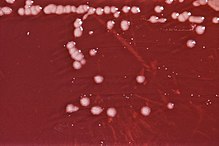| Pseudomonas | |
|---|---|

| |
| P. aeruginosa colonies on an agar plate | |
| Scientific classification | |
| Domain: | Bacteria |
| Phylum: | Pseudomonadota |
| Class: | Gammaproteobacteria |
| Order: | Pseudomonadales |
| Family: | Pseudomonadaceae |
| Genus: | Pseudomonas Migula 1894 |
| Type species | |
| Pseudomonas aeruginosa | |
| Species | |
|
See text. | |
| Synonyms | |
| |
Pseudomonas is a genus of Gram-negative bacteria belonging to the family Pseudomonadaceae in the class Gammaproteobacteria. The 313 members of the genus[2][3] demonstrate a great deal of metabolic diversity and consequently are able to colonize a wide range of niches.[4] Their ease of culture in vitro and availability of an increasing number of Pseudomonas strain genome sequences has made the genus an excellent focus for scientific research; the best studied species include P. aeruginosa in its role as an opportunistic human pathogen, the plant pathogen P. syringae, the soil bacterium P. putida, and the plant growth-promoting P. fluorescens, P. lini, P. migulae, and P. graminis.[5][6]
Because of their widespread occurrence in water and plant seeds such as dicots, the pseudomonads were observed early in the history of microbiology. The generic name Pseudomonas created for these organisms was defined in rather vague terms by Walter Migula in 1894 and 1900 as a genus of Gram-negative, rod-shaped, and polar-flagellated bacteria with some sporulating species.[7][8] The latter statement was later proved incorrect and was due to refractive granules of reserve materials.[9] Despite the vague description, the type species, Pseudomonas pyocyanea (basionym of Pseudomonas aeruginosa), proved the best descriptor.[9]
- ^ Lalucat, Jorge; Gomila, Margarita; Mulet, Magdalena; Zaruma, Anderson; García-Valdés, Elena (2021). "Past, present and future of the boundaries of the Pseudomonas genus: Proposal of Stutzerimonas gen. nov". Syst Appl Microbiol. 45 (1): 126289. doi:10.1016/j.syapm.2021.126289. hdl:10261/311157. PMID 34920232. S2CID 244943909.
- ^ Parte, Aidan C.; Sardà Carbasse, Joaquim; Meier-Kolthoff, Jan P.; Reimer, Lorenz C.; Göker, Markus (2020). "List of Prokaryotic names with Standing in Nomenclature (LPSN) moves to the DSMZ". International Journal of Systematic and Evolutionary Microbiology. 70 (11): 5607–5612. doi:10.1099/ijsem.0.004332. PMC 7723251. PMID 32701423.
- ^ "Genus Pseudomonas". LPSN.dsmz.de. Retrieved 4 April 2023. Partial citation, see Parte et al., 2020 for project reference
- ^ Madigan M; Martinko J, eds. (2006). Brock Biology of Microorganisms (11th ed.). Prentice Hall. ISBN 0-13-144329-1.
- ^ Padda, Kiran Preet; Puri, Akshit; Chanway, Chris (2019-11-01). "Endophytic nitrogen fixation – a possible 'hidden' source of nitrogen for lodgepole pine trees growing at unreclaimed gravel mining sites". FEMS Microbiology Ecology. 95 (11). doi:10.1093/femsec/fiz172. ISSN 0168-6496. PMID 31647534.
- ^ Padda, Kiran Preet; Puri, Akshit; Chanway, Chris P. (2018-09-20). "Isolation and identification of endophytic diazotrophs from lodgepole pine trees growing at unreclaimed gravel mining pits in central interior British Columbia, Canada". Canadian Journal of Forest Research. 48 (12): 1601–1606. doi:10.1139/cjfr-2018-0347. hdl:1807/92505. ISSN 0045-5067. S2CID 92275030.
- ^ Migula, W. (1894) Über ein neues System der Bakterien. Arb Bakteriol Inst Karlsruhe 1: 235–238.
- ^ Migula, W. (1900) System der Bakterien, Vol. 2. Jena, Germany: Gustav Fischer.
- ^ a b Palleroni, N. J. (2010). "The Pseudomonas Story". Environmental Microbiology. 12 (6): 1377–1383. Bibcode:2010EnvMi..12.1377P. doi:10.1111/j.1462-2920.2009.02041.x. PMID 20553550.